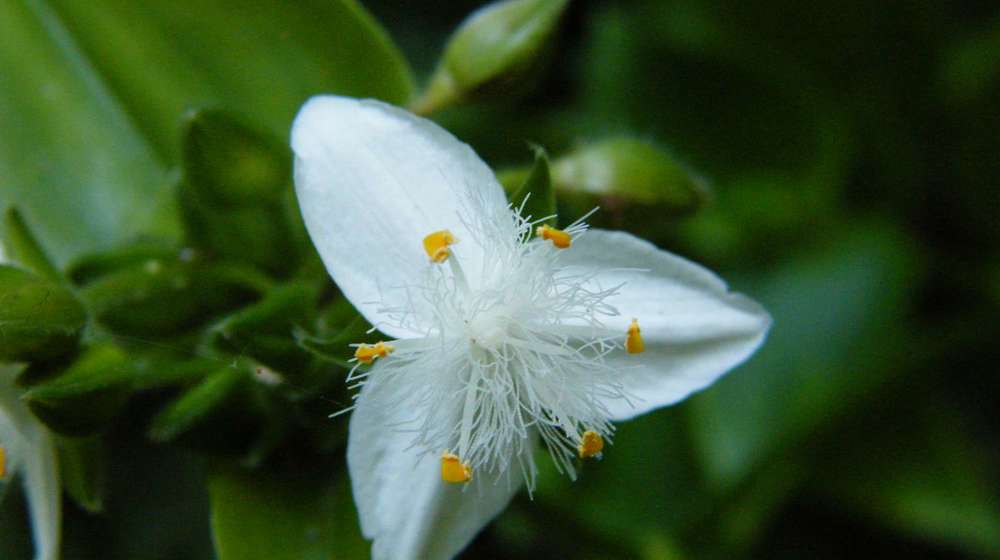-
-
-
-
-
-
-
-
-
-
Tradescantia
-
-
-
-
-
-
-
-
-
-

Tradescantia / wandering willie
| Common name: | Tradescantia/wandering willie |
| Scientific name: | Tradescantia fluminensis |
| Management programme: | Site-led |
Tradescantia, also known as Wandering Willie, forms dense mats that smother the ground in lightly to deeply shaded areas and prevents native seedlings from growing. It can survive thick shade, lots of damage and grazing, wet soil types, and high and low temperatures, but not frost or drought conditions.
It can be spread through stem fragments, either naturally by water movement or by livestock or humans through soil movement, dumped vegetation, or machinery.
- Size: Trailing perennial groundcover species with creeping stems that can form dense mats over large areas.
- Leaves: Dark green oval leaves with pointed tips that are smooth, shiny and
- slightly fleshy.
- Flowers: White three-petalled flowers in small clusters are produced from December to January. No fruit or seed is produced in New Zealand.
- Root system: Stems root at all nodes—the part of the stem that touches the ground—creating vast root systems.
- Habitat: Includes most damp, shaded habitats, especially disturbed and previously grazed forest, shrubland, streamsides, river systems, loose soil terraces, fernlands, and wetlands. New infestations from stem fragments easily spread down waterways or next to existing infestations.
Tradescantia can be easily identified by its three-petalled flowers in summer (December-January).
To prevent or improve on damage to indigenous ecosystems, tradescantia is in the site-led programme of the Otago Regional Pest Management Plan (2019-2029). The Dunedin site-led areas include West Harbour — Mt Cargill and Quarantine and Goat islands — and Otago Peninsula. There are no specific rules associated with site-led pest plants in the plan.
Tradescantia is declared an unwanted organism in the National Pest Plant Accord. This means it cannot be sold or be in a place where plants are being sold. It cannot be propagated, bred, multiplied, communicated, released, caused to be released, or otherwise spread.
ORC will take a lead role in supporting the goals of community groups and agencies in site-led areas in relation to tradescantia. This may be through advice, education, funding, service delivery or requiring other landowners undertake control when needed.
Physical control:
- For small patches, you can rake and roll up the plant working towards the centre. This works best in a drought period.
- Dispose of at a refuse transfer station, burn or bury.
- You should use foliar spray to follow up physical control to make sure there are no leftover fragments that can spread the infestation.
Chemical control:
- Spray foliage with triclopyr plus a wetter/penetrant and thoroughly wet all parts of the plant.
- All remaining stem fragments may resprout. To effectively control tradescantia, treat 2–3 times, over 2–3 months, before replanting the area.
Caution: When using any herbicide or pesticide, please read the label thoroughly to ensure that all instructions and safety requirements are followed.
Disclaimer:
Mention of product trade names does not endorse these products nor imply criticism of similar products not mentioned. The Otago Regional Council does not give any warranty that the information is accurate or complete or that it is suitable for all circumstances.
Site-led
Site-led programmes have rules for specific pests that only apply in that area. Site-led areas have special biodiversity and other values to protect.
National Pest Plant Accord (NPPA)
Any plant listed on the NPPA is an unwanted organism under the Biosecurity Act 1993. This means they cannot be distributed or sold in New Zealand.

November 2019
Otago Regional Council
ISBN 978-0-908324-57-6
PDF | 5 MB
The Otago Regional Pest Management Plan focuses on dealing with harmful pests that impact our environment, economy, and communities. It identifies species like rabbits, wallabies, gorse, and wilding conifers that cause problems on our land. Guided by the Biosecurity Act 1993, the plan works with stakeholders to set rules and controls for managing pests. Through consultation, it aims to protect our region's unique ecosystems and species from the damage caused by these invasive organisms.

August 2025
PNG | 907 KB
Tradescantia, also known as Wandering Willie, forms dense mats that smother the ground in lightly to deeply shaded areas and prevents native seedlings from growing.
www.orc.govt.nz/tradescantia








